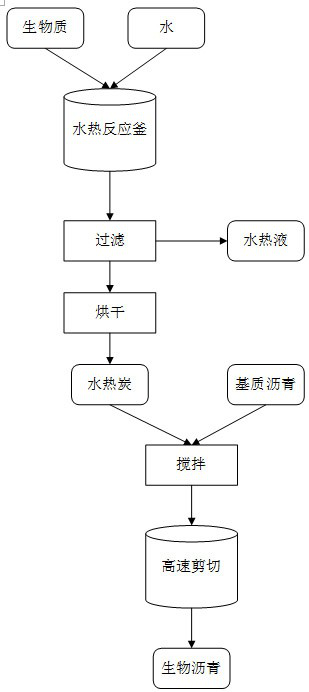A method for preparing bio-asphalt from lignocellulosic biomass hydrothermal charcoal
A technology of lignocellulose and bio-asphalt, which is applied in the field of environmental protection and comprehensive utilization of resources, can solve the problems of increasing dependence on petroleum resources, pollution and emissions, high prices of asphalt modifiers, and obstacles to resource conservation, achieving combination stability and improving high temperature The effect of high performance and great economic benefits
- Summary
- Abstract
- Description
- Claims
- Application Information
AI Technical Summary
Problems solved by technology
Method used
Image
Examples
Embodiment 1
[0025] After the corn stalks were dried and crushed into powder, 150 g and 2250 g of water were placed in a 3 L Hastelloy hydrothermal reaction kettle, and heated to 300° C., stirring continuously during the heating process. When the temperature of the mixture reaches the preset value of 300° C., keep the reaction for 1 hour and keep stirring. After the reaction was completed, the temperature was cooled down to room temperature, and the obtained product was separated by filtration. The obtained solid was filtered, dried at 80° C. for 12 hours to remove moisture, and hydrothermal charcoal was obtained. Combine the hydrothermal charcoal obtained above with Shell 70#PEN60 / 70 asphalt to prepare bio-asphalt. The specific steps are as follows: heat the base asphalt to 135°C and slowly pour in hydrothermal charcoal with a mass of 2% and 6% base asphalt respectively , and stirred rapidly for 15 minutes; continue to heat the mixture to 165 ° C, and under the action of a high-speed she...
Embodiment 2
[0030] After the wheat straw was dried and crushed into powder, 100g and 2000g of water were placed in a 3L Hastelloy hydrothermal reaction kettle, and heated to 330°C, stirring continuously during the heating process. When the temperature of the mixture reached the preset value of 330° C., the reaction was kept for 1 hour with constant stirring. After the reaction was completed, the temperature was cooled down to room temperature, and the obtained product was separated by filtration. The obtained solid was filtered, dried at 120° C. for 2 hours to remove moisture, and hydrothermal charcoal was obtained. Combine the hydrothermal charcoal obtained above with Shell 70#PEN60 / 70 asphalt to prepare bio-asphalt. The specific steps are as follows: heat the base asphalt to 130°C, slowly pour in hydrothermal charcoal with a mass of 10% base asphalt, and quickly Stir for 20 minutes; continue to heat the mixture to 170° C., and shear for 40 minutes under the action of a high-speed shear...
Embodiment 3
[0032] After drying Salix twigs, pulverize them into powder, take 200g and 2000g of water and place them in a 3L Hastelloy hydrothermal reaction kettle, and heat them to 250°C, stirring continuously during the heating process. When the temperature of the mixture reached the preset value of 250° C., the reaction was kept for 5 hours with constant stirring. After the reaction was completed, the temperature was cooled down to room temperature, and the obtained product was separated by filtration. The obtained solid was filtered, dried at 105° C. for 5 hours to remove moisture, and hydrothermal charcoal was obtained. Combine the hydrothermal charcoal obtained above with Shell 70#PEN60 / 70 asphalt to prepare bio-asphalt. The specific steps are as follows: heat the base asphalt to 140°C, slowly pour in hydrothermal charcoal with a mass of 4% base asphalt, and quickly Stir for 10 minutes; continue to heat the mixture to 160°C, and shear for 90 minutes under the action of a high-speed...
PUM
 Login to View More
Login to View More Abstract
Description
Claims
Application Information
 Login to View More
Login to View More - R&D
- Intellectual Property
- Life Sciences
- Materials
- Tech Scout
- Unparalleled Data Quality
- Higher Quality Content
- 60% Fewer Hallucinations
Browse by: Latest US Patents, China's latest patents, Technical Efficacy Thesaurus, Application Domain, Technology Topic, Popular Technical Reports.
© 2025 PatSnap. All rights reserved.Legal|Privacy policy|Modern Slavery Act Transparency Statement|Sitemap|About US| Contact US: help@patsnap.com

